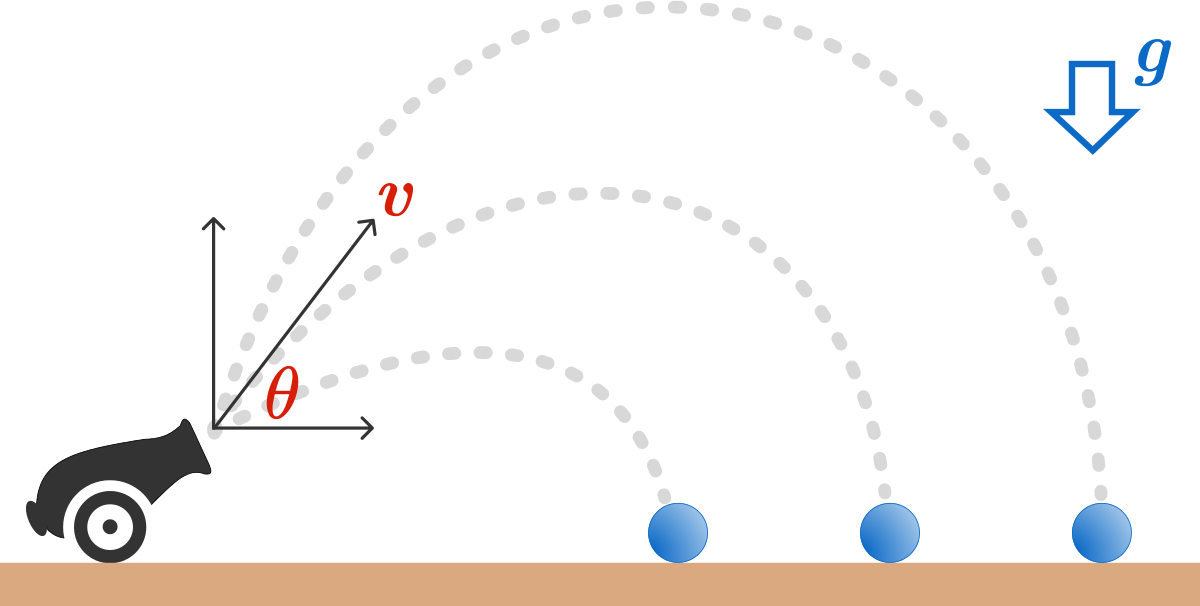Cannon Shot Variance
A cannonball is shot from ground level with a velocity of magnitude and a launch angle of with respect to the ground.
Suppose many shots are fired. Over the many trials, varies uniformly between and , and varies uniformly between 0 and . Gravity is downward.
Let be the horizontal distance from the firing location to the cannonball's landing location. What is the variance of (in square meters)?
Inspiration
You may want to try
this one
first to get warmed up
Note: The listed answer is an approximation

The answer is 34348045.7878.
This section requires Javascript.
You are seeing this because something didn't load right. We suggest you, (a) try
refreshing the page, (b) enabling javascript if it is disabled on your browser and,
finally, (c)
loading the
non-javascript version of this page
. We're sorry about the hassle.
Let us call velocity in the x -axis as v x and velocity in the y -axis as v y .
Thus:
v x = v cos ( θ )
v y = v sin ( θ )
Being t the time for the ball to reach its highest point from ground:
0 = v y − 1 0 t
t = 1 0 v sin ( θ )
The total time that the ball will be in air is 2 t , and then:
D = v x ⋅ 2 t
D = 1 0 v 2 sin ( 2 θ )
So, the variance will be:
σ 2 [ D ] = E [ D 2 ] − E 2 [ D ]
σ 2 [ D ] = [ 5 0 0 1 ⋅ 2 π 1 ∫ 0 2 π ∫ 0 5 0 0 1 0 0 v 4 sin 2 ( 2 θ ) d v d θ ] − [ 5 0 0 1 ⋅ 2 π 1 ∫ 0 2 π ∫ 0 5 0 0 1 0 v 2 sin ( 2 θ ) d v d θ ] 2
σ 2 [ D ] = ⎣ ⎡ 2 5 0 0 0 π 1 5 1 v 5 ∣ ∣ ∣ ∣ ∣ 0 5 0 0 ⋅ ∫ 0 2 π ( 2 1 − cos ( 4 θ ) ) d θ ⎦ ⎤ − ⎣ ⎡ 2 5 0 0 π 1 3 1 v 3 ∣ ∣ ∣ ∣ ∣ 0 5 0 0 ⋅ 2 cos ( 2 θ ) ∣ ∣ ∣ ∣ ∣ 2 π 0 ⎦ ⎤ 2
σ 2 [ D ] = ⎣ ⎡ 2 5 0 0 0 π 1 5 1 5 0 0 5 ⋅ ⎝ ⎛ 4 π − 8 sin ( 4 θ ) ∣ ∣ ∣ ∣ ∣ 0 2 π ⎠ ⎞ ⎦ ⎤ − [ 2 5 0 0 π 1 3 5 0 0 3 ] 2
σ 2 [ D ] = 5 0 0 0 0 0 5 0 0 5 − 5 6 2 5 0 0 0 0 π 2 5 0 0 6
σ 2 [ D ] ≈ 3 4 3 5 5 2 2 6 . 7 6 6